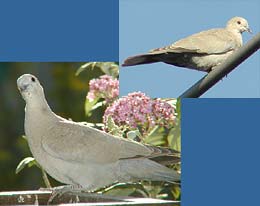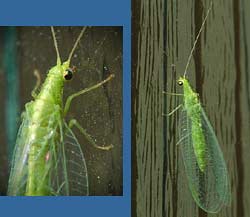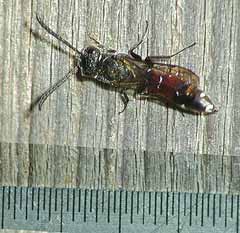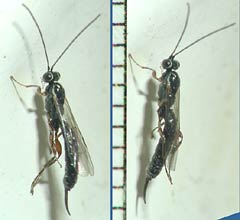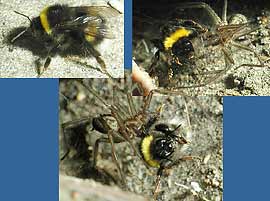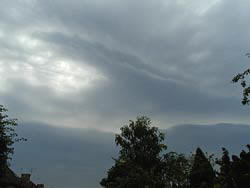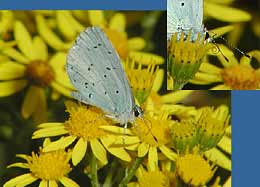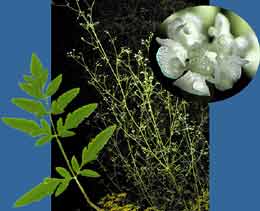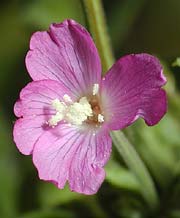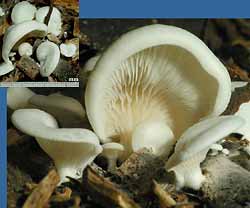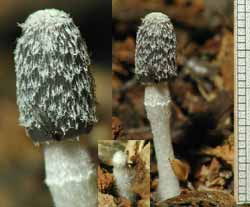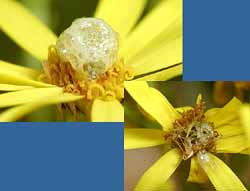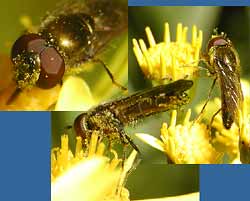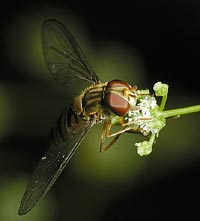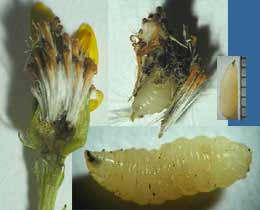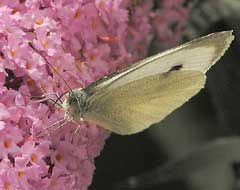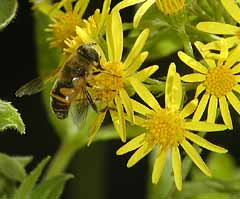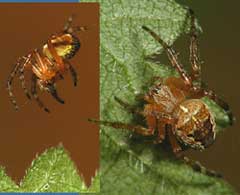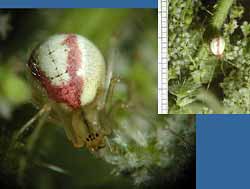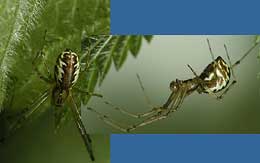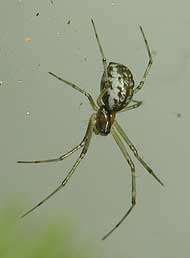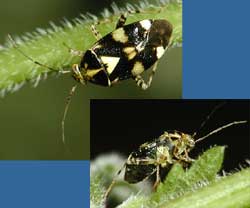Go to last entry.....................................Go to previous entry15 July - The very warm weather continues with the high temperatures increasing each day. Each of the last three days have exceeded 30C in the garden with it up to 34-35C in the garden this afternoon (although the highest official temperature was 33.5C at nearby Wisley). The weather forcaster on TV has just promised that it will gradually cool down as the week progresses, with the prospect of thunder storms.
This first one is of a young Collared Dove which, despite its name, has not yet developed its collar. It is a regular to the bird table at the moment. The Song Thrush is still taking the occasional raisin away after it has eaten, and so is the female Blackbird. Yesterday a fledgling Dunnock was here, following its parent (the bird with the injured leg) and making lots of noise as it begged for food.
On a much smaller scale, there have been a number of these delicate lacewings (Chrysopa 7-punctata) in the garden. This one was spotted on the kitchen window. The latin name refers to seven tiny black spots on the head - I shall have to photograph one more closely to show these. They look particularly vulnerable when they fly about slowly with their two pairs of wings flapping vigorously.
This is the first of two unidentified possible wasps that I have managed to photograph in the last three days. They were particularly nervous insects and I couldn't get close enough to get good images. This one has red coloured segments at the front end of the abdomen and irregular white marks on the reara, black segments. It measured about 12mm long.
Seen today, this much more slender individual is about 6mm long (excluding the ovipositor at the rear). It is black, with reddish legs. It is likely to be an Ichneumon fly, a parasitic species that could be interested in the nests of the solitary bees that were nearby.
The final images illustrate a dilema faced when you try to take photographs of any wildlife in a dispassionate way. Do you interfere to rescue the prey, or do you allow nature to take its course? My choice is, I hope, always the latter.
After pulling the bee back into the hole, tangling it up with more silk and getting all of its legs off the ground the spider sank in its fangs and had a late breakfast!
There may be an interruption to my diaries over the next couple of days. The long overdue replacement computer should arrive in the next day or two and I will need learn something of the workings of Windows XP Pro, and find out which bits of my old software I can or cannot transfer from the old machine (Win98). If time permits I may try to connect both old and new to my broadband connection in order to maintain continuity and then wait until after our Summer holiday to sort things out properly.
1 The sunshine deserted us today, for all but about a minute in the late afternoon, when the temperature was struggling to get up to 21C, a full 12 - 13C lower than the same time yesterday. We have had showers on and off all day, although there has been no heavy rain. Despite the threatening appearance of the sky this morning did I see or hear any sign of the thunderstorms that were forecast.
18 July - Just a short note again today, this time via my new computer and Microsoft's FrontPage 2002 software, as my old Adobe Pagemill website program is too old to work with Windows XP. There is a lot to learn, although not at the total expense of the garden which must have some of my time this weekend! I haven't got round to linking both old and new computers yet, but now that I can access my website I may leave that task until after the Summer holiday. One thing that is promising about the new machine is that I now have the capability of running two webcams from it simultaneously if things in the birdbox(s) get really interesting next Spring. Anyway, we have had some sunshine today, with no rain, and the temperature was back up to around 26C. While the nesting season seems to be nearly over there was a sparrow fledgling begging for food this morning. The leaf-cutter bees and the other solitary bees continue their activities. Now to find out if this update will get to the website.......
We were away from home most of the day but as we relaxed outside in the late afternoon I had the chance to take some images of this Holly Blue butterfly as it fed on some of the healthy flowers of the Ragwort plant. I included the smaller image to show the Holly Blue's proboscis partly curled up into its storage position Growing in the middle of the group of Ragworts is a single plant that has, over the last couple of weeks, grown to to tower over its neighbours. Measuring just over 2.3m in height, it has smooth, round stems, tiny white flowers (top right - measuring about 1-1.5mm across) grouped into umbels, usually of six individual flowers. The leaf shown is from the lower part of the plant and measures about 15cm in length. I've compared it with images and descriptions in several wild flower guides but without luck so far. Now that the flowers have started opening I shall have to try again.
Another plant in flower now is the Great Willowherb. It should have flowered sooner but many of the early buds were destroyed by insect larvae, a problem the plants also experienced in previous years.
20 July - The good weather continues with another warm, sunny day, although a constant breeze did make some photography a bit difficult.
The first, pictured here, are white in colour and have a short stem which is offset towards the side of the cap on the larger examples. The largest has a cap about 2.5cm across. Based on my fungi guides I think that it is one of the Pleurotus species, the nearest pictorial match I can find being Pleurotus lignatilis.
The second type is represented by this solitary fruiting body (plus a small, new body that is developing close by - image bottom-centre of picture). Photographs in one of my fungi guides suggests that this could be an immature fruiting body of one of the Ink Cap fungi (Coprinus sp.), although I can't find an exact match.
This does not last long, and afterwards the flowers look pretty dreadful (bottom-right). I assume that the froth is being produced by the larval stage of the fly, although I'm not sure why is is only a short-lived effect. I need to dissect a flower to investigate.
The healthy flowers are attracting a lot of solitary bees and hoverflies similar to this one. I mentioned the breeze - that made for an interesting challenge as I tried to record these images.
The plant with the tiny white flowers (pictured yesterday) continues to defy my attempts at identification, but today its flowers are becoming irresistible our most common hoverflies, Episyrphus balteatus. With the breeze constantly moving the delicate branches it took a lot of attempts to get this one!
21 July - On another very warm, dry day, most of my time has been taken up with preparations for our Summer trip away in our 'summer-house' (caravan). We had intended to head for West Wales this time but it's back to Cornwall again. I spent a bit of time this morning to investigate the damaged Ragwort flowers. Splitting them open revealed that there was a cavity where the developing seeds should be and a grub which was, in most cases, hidden amongst the florets. These grubs must be the developing offspring of the flies that appeared as the early flower buds developed in the second half of June. The buds that matured later were not affected and are now producing normal blooms. I will probably remove most of the Ragwort before I leave for the holiday in order to minimise their seed production.
23 July - Today has seen the weather gradually going downhill with lots of threatening clouds moving in from the West and it turning damp tonight.
The visitors included a Comma and a Red Admiral, but the only one that did not dash off too quickly was this Large White.
The Ragwort flowers attracted the attention of this large Drone Fly, the second one that I've seen this week.
I spent some time doing some clearing of plants that have gone to seed. The Oxeye Daisies were the first to go, exposing a lot of new leaf growth below the old stalks. Most of the Nipplewort plants have also been removed. Then I started cutting back the Stinging Nettles to encourage new growth, checking each bit for animals. The camera was soon back in use as the spiders appeared.
The first was this small, reddish brown individual which was sitting at the centre of a web until disturbed by me. I think it is one of the Nuctenea species, possibly Nuctenea cornuta.
The second was this Enoplognatha ovata (I think) female, found resting amongst the nettle flowers.
The last two spiders will have to wait until tomorrow before I look through my guides. Both have a body length of about 5mm.
Finally, I found two of these small bugs on the Nettles. About 5mm long, it closely matches the illustration of Liocoris tripustulatus in my Collins insect guide, and is known as the Common Nettle Capsid.
Finally, the most important event of the day - Sheila has come home for the last time as a full-time teacher. All the stresses and strains that the job brought with it have been shaken off and from now on she will choose for herself when she wishes to enter the classroom again! Preparation for our holiday will now start in earnest.....
26 July - Typical, isn't it, that as we get ready to head off West to Cornwall again the weather has turned foul. As usual, my sons will still be checking on things but I though I'd save them one job. This afternoon I found myself connecting up a timer to a system to keep some container bound plants watered and the ponds topped up over the next few weeks -in the rain! I have removed most of the ragwort plants and several of the Great Willowherb to minimise the amount of seed that will be produced in my absence, The kayak is on the car and my camera kit is packed, and the forecast is much better for our journey tomorrow. The diary will resume some time in August. |
|
